- Author travels to 9 lesser known temples in Kashmir
Valley, tells you about their architecture-history and current state.
Last spring, my friends and I planned a trip to
Kashmir. We are originally from Srinagar but now live across India. An
important element of the week-long itinerary was to go on a temple trail in the
Valley. At the end of the trip, I can confidently say that Kashmir has truly
been a spiritually rich and sacred land. Its vast landscape is dotted with
shrines, most of them built out of blocks of stone. Almost all of them are
dedicated to the lord of the universe - Shiva.
To see some of these temples we had to criss-cross
from South to Central to North Kashmir. The experience was enriching and that
of a lifetime. Although, our trip included several shrines, this piece is only
on select nine, which usually a regular traveller, including a Kashmiri, would
miss.
1. LODUV (dedicated to Shiva)
Our flight to Srinagar landed very early in the
morning and after checking out, we straight away drove to village Loduv, which
is about 20 km from the saffron town of Pampore in district Pulwama. Saffron
blooms only in late autumn, this was spring and there were endless mustard
fields in full bloom!
Unfortunately, Google is not properly updated with
these obscure locations, so you have to rely a lot on your pre-work, experience
of cab driver and elderly locals that you meet enroute.
As we drove through the village, it was very easy to
spot the roofless temple on one side of the road. It gave a very forlorn look,
although it sat pretty in the middle of a water body. There were lofty Chinars
along the roadside and a couple of shacks selling items of daily use. A Sufi
shrine stood at the back of it. We couldn’t wait to get off the car and as this
was the first stop in our journey, everyone was high on energy and excitement.
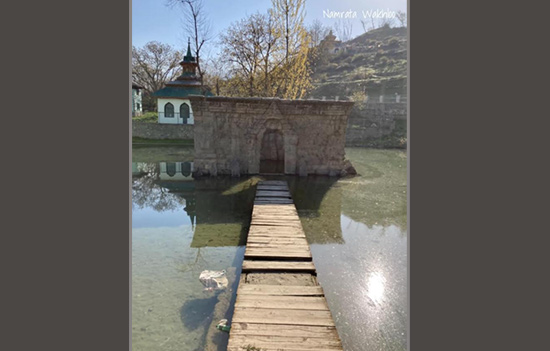
The temple of Loduv is considered to be the oldest of all
temples in Kashmir. The temple, which dates back to the 8th CE, sits in the
middle of a shallow tank, which gets water from a natural spring in its
north-east corner. The square shrine is very simple in design, with a trefoil
entrance, so typical of all Kashmir temples of that era. A walkway made of
wooden planks connects the main entrance from the road to the shrine. The roof,
which once would have given it a majestic appearance to the structure is
missing now.
The site is under the ASI and the gate was locked, so
there was no way to go inside the shrine. We did not want to leave without
exploring the place a bit. So, we went around the temple periphery and then
climbed down the wall to have a closer look at the temple from across the tank.
We could see lots of fish in the tank, which unfortunately has not been kept
very clean. A lot of trash was floating here and there.
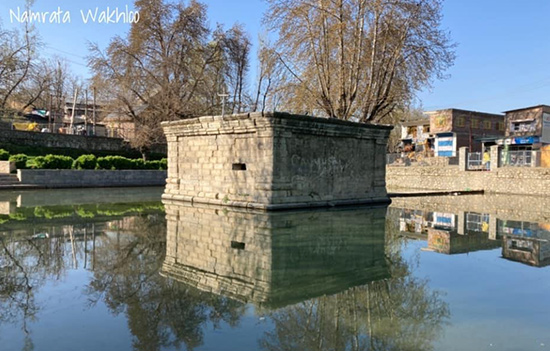
Something very interesting to recount. We met a local
Muslim lady who had come to offer the “first milk” of a lactating cow that had
just given birth to a calf. She said, it’s a practice in the village, to offer
this milk to the sacred Nag ( which
means both - spring and the serpent residing in it), every time someone’s cow
delivers a baby. She felt it was these Hindu and Muslim shrines which are
abundant in the Valley, that watch over the Kashmiri people. The same practice
was later reconfirmed to us by a Hindu priest at Mattan Nag where too the
villagers come and offer the first milk to the Nag.
2. PAYAR (dedicated to Shiva)
The drive from Avantipura to Payar will go down as one
of the most scenic ones in my lifetime. Just 12 km from Avantipur, and 45 km
from Srinagar, lies the idyllic village of Payar. Also known as Payach, it’s 3
km from the main Pulwama district headquarters. It was Spring, and we were on
this quiet village road which had almond and pear orchards on either sides. The
trees were laden with gorgeous pink and white blossoms. The ground below was
full of these dainty petals. All we could spot, for acres together, were a
couple of shepherds grazing their sheep in the orchards. Being Pulwama, which
is notorious for breeding terror, the driver was initially skeptical to stop
here, but looking at our awe-filled faces, he threw caution to the winds and
offered to stop here for a while. We, like one excited bunch of schoolkids,
went berserk in the Yash Chopraesque locale!
Once we entered the village, we were guided into small
lanes and told that the temple was next to a school. One of the village elders
heard us enquiring, and he accompanied us to the shrine, as he was the one
entrusted by ASI with the key.

The small 11th CE Shiva shrine which is open on all
sides, is nothing short of an exquisite gem in the middle of a bustling
neighbourhood. This is one rare old stone temple, where the roof is still
intact. And not only that, it is said to weigh a little more than 7 tons! The
pyramidal roof has triangular pediments on all the four sides enclosing a
trefoil arch on each. On each trefoil niche, there are images of Shiva and
other deities carved on it. The shrine is 8 sq. ft in area and 21 ft. high from
the ground. The sanctum is open on all sides and can be reached by a short
flight of steps on the eastern side. It holds a huge Shivling at the centre of
it. The ceiling is beautifully carved. There is a well manicured garden around
the temple where the flowers had just started to sprout.
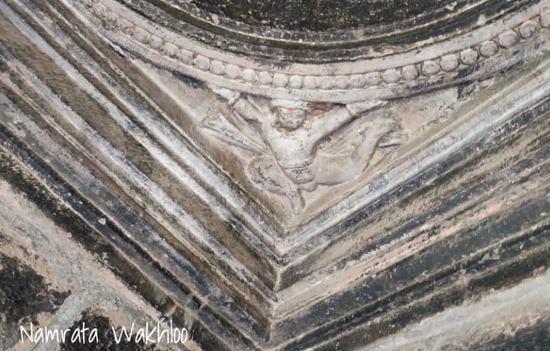
The shrine is well maintained and was promptly locked
by the caretaker once we left. I would wait for the day when the gates to these
shrines are left open forever and one can hear chanting, ringing bells and
conch sounds fill up the air.
3. BONIYAR (dedicated to Shiva)
Boniyar town is on the banks of river Jhelum, on the
road between Baramulla to Uri in North Kashmir. As we had a long day ahead, we
started the day early having to go almost upto the LOC at Uri. Srinagar to
Baramulla is 53 km and you get to drive through very scenic poplar-lined
avenues. As a rule we always started early.
We didn’t stop at Baramulla but continued straight to
Boniyar which is about 25 km away, just a few km short of Uri. The drive from
Baramulla to Uri gets even more mesmerizing as you continue to follow the
Jhelum downstream on one side while you have tall mountains on the other. The
roads are quite good.
The 9th CE Boniyar temple is said to be the best
surviving specimen of Kashmiri architecture. The temple was constructed by the
rulers of the Avantivarman dynasty. The original image of Vishnu is no longer
there so a Shiv Lingam found from a river bed has been placed instead.
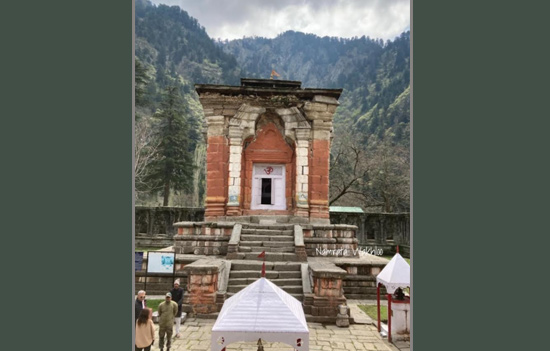
The quadrangle or the cellular peristyle, within which the shrine sits, measures 145' by 119 1/2', and consists of 53 cells and the gateway. Each cell is 7' by 4' in size. One look at the colonnade strongly reminds you of something similar you would’ve seen at Martand.
The entire structure is very imposing. It’s built on a
double plinth with two ambulatory passages that can be reached by separate
staircases. In front of the temple is a platform, where a column dedicated to
Garuda, once stood. The sanctum sanctorum has a single entrance and recesses on
the other three, all framed by pedimented trefoils. It’s interesting to note
that while most temples in Kashmir used limestone, this
temple was made from blocks of granite. This grey granite stone is
nowhere seen on this side of Jhelum, so one can safely assume what effort must
have gone into ferrying them from across the other bank.
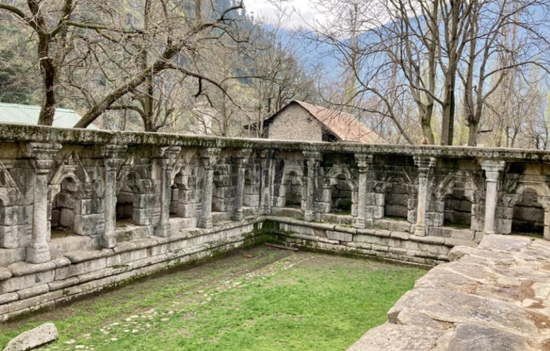
The temple is being taken care of by ASI and the Army.
You need to seek permission from the army officer incharge before you can enter
the premises.
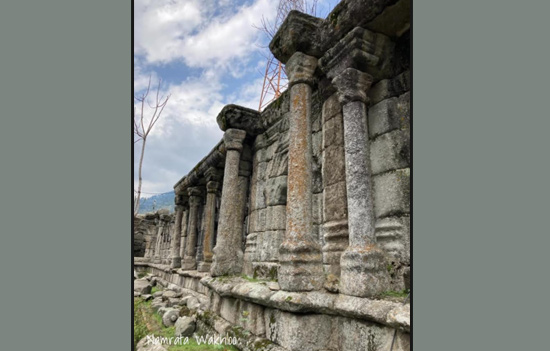
In fact, we were met by a senior officer from BSF, who
ensured that someone gave us the complete background and significance of the
temple. We enjoyed our packed lunch at their Mess which was right on the banks
of Jhelum, along with some freshly-made pakoras and chai!
4. DATTA (dedicated to Vishnu)
Datta Mandir is at a short distance from Boniyar
temple. It’s actually Detha Mandir Bandi according to ASI and is believed to
have been built in the 10th century in the typical Kashmiri style of
architecture. Legend says that this temple was actually built by the Pandavas
during their exile. The stones used to build this temple were carried by Bheema
all the way from the nearby mountains. This temple is situated on the banks of
Jhelum.
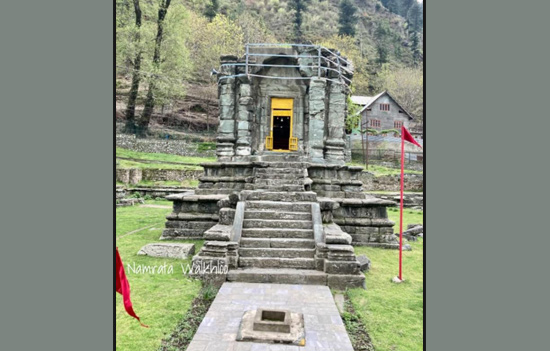
This magnificent temple was desecrated in 1947 during
the Pakistani tribal attack. Many ancient idols were damaged and sacred
ornaments were stolen. The Indian army installed a beautiful marble Shiva there
in 1992.
Unfortunately, there is not much information available
about this sacred temple.
5 & 6 SUGANDESHA & SANKARAGAURISHVARA (dedicated
to Shiva)
A couple of years back, when I was travelling from
Srinagar to Kupwara, I caught a fleeting glimpse of some beautiful ruins of two
stone temples quite close to each other, on the right side of the main road in
Pattan town. They looked very typical of old Kashmir temples, like the ones I
had seen at Avantiswamin and Martand. I looked them up online and made a mental
note to add them to my next visit to Kashmir. This ultimately resulted in the
temple trail, that we went on, this spring.
Pattan is a town in Baramulla district in North
Kashmir, about 27 km from Srinagar.
The twin temples were laid in 9th CE by King
Sankarvarman who succeeded his father King Avantivarman. Both the temples,
which resemble the Avantiswamin temple, are mostly in ruins now. They are Shiva
shrines.
The area used to be called Sankarapura Pattana and was
the capital of Sankarvarman’s kingdom. While he named the smaller temple as
Sankaragaurishvara, the bigger one was named by him after his wife Queen
Sugandha. The temples are about 300 m apart and are under the watch of ASI.
Beautiful gardens have been laid around them and you see people relaxing in the
shades of huge Chinars! In neither of the temples, was any Shivling or idol of
Shiva present.
Sugandesha shrine stands on a square double base
and has a portico in the front with foiled niches on three sides externally
which might have contained images. It has a peristyle similar to that of the
Avantiswamin Temple with the entrance on the eastern wall. The cells had a row of
fluted columns.
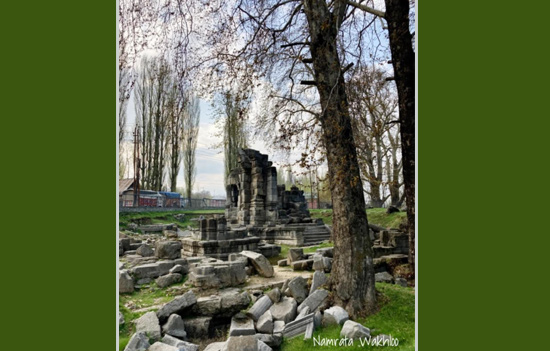
Architectural members lying in the courtyard include
fragments of fluted columns, brackets, rosettes and figures of atlantes. This
temple is said to have been built with material plundered from Parihaspura - the
capital city founded by of King Lalitaditya more than a century before this.
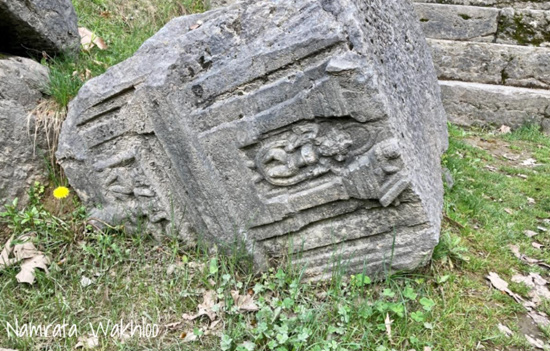
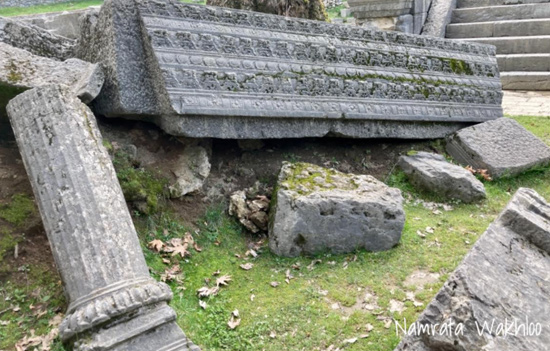
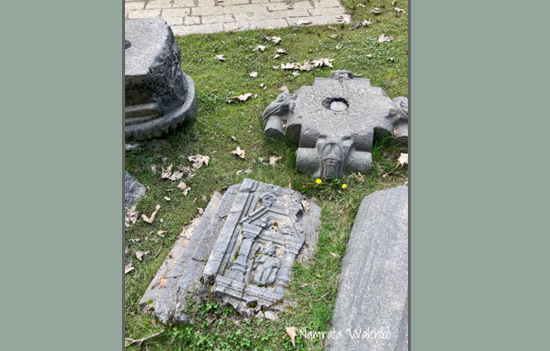
Sankaragaurishvara Shrine, at the first glance, appeared to me
as a square walled structure which reminded me of the temple at Martand or
Sharda, but much smaller. The temple’s entrance porch faces east and has
intricately sculpted carvings on its exterior walls as well as on the interior.
The columns at the entrance are also beautifully sculpted in the typical
architectural style of Kashmir. The plinth of the temple, and of the shrine next
to it, is built in a peristyle — an open colonnaded pattern, within a walled
enclosure, which forms a cellular passage, remnants of which can still be seen.
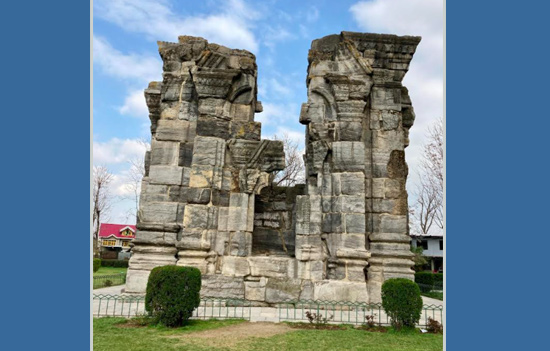
Kalhana, the great historian of Kashmir, has
documented these temples in his epic work-Rajtaringini.
7. PARIHASPURA
After visiting the temples in Pattan, our next stop for the day was Parihaspura ruins. It was already early evening and since the cab driver had never been there, we had to rely on Google. The directions showed us that place was a few kilometres off the Pattan - Srinagar highway, into the interiors. After a long picturesque drive on the narrow winding roads through breathtakingly pretty mustard fields, we realized that we were lost. Ultimately, relying on human intelligence available in the form of locals, we were guided towards the right direction. We had driven some extra 10–12 kilometres in a different direction. But the detour gave us a beautiful drive of 30 extra minutes right into the hamlets, which one would rarely go into, otherwise.

My friends were a little disappointed for the time
lost as they wanted to be back in Srinagar for some last minute shopping, as
two of them were leaving the very next day. They decided to call the hunt off!
But the driver and I were keen to succeed in this mission, so we gave it a good
try, checking with locals at every turn and crossing, until we finally made it.
We did get curious glances from the people of these villages, as very rarely
would any visitors be seen visiting this monument.
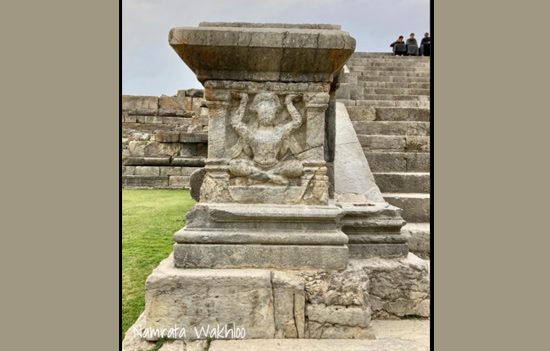
Parihaspura in Sanskrit means a “city of laughter” or
a “smiling city”. Lalitaditya founded this city in 7th - 8th CE and moved his
capital from Srinagar to Parihaspur. The historian Kalhana writes that the King
built his residence and four temples here. The temples included one for Vishnu
(Muktakeshva) where the emperor supposedly used 84,000 tolas of gold
to make the image of Vishnu. In another temple, he used as
many palas of silver for the image of Parihaskesana. He also had made
a statue of Buddha in copper, that according to Kalhana “reached up to the
sky.” The main temple was larger than the grand temple that Lalitaditya built
in Martand.
Had Parihaspur not been plundered and
pillaged over and over again, it probably would have been the grandest complex
of palaces and temples from that era.
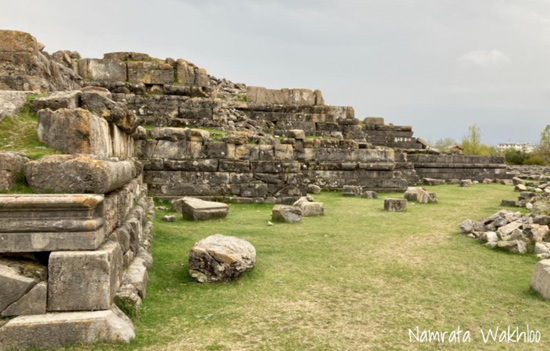
A lot of destruction occurred when Avanti Varman’s son
Shankar Varman moved his capital to the new city of Sankarapura Pattana. He
cannibalized precious material from these temples and palaces to build his own
city. Later, during the war between King Harsha and Uccala in 11th CE, Uccala
sought refuge in Parihaspur. King Harsha suspecting the same, set the place on
fire. Finally, the temples were demolished by the invader Sultan Sikandar in
the 14th CE. (source: wiki)
Now, the ruins are known as “Kani Shahar” (city of
stones). As we got off our car, our eyes took in the huge expanse of land - we
could see a huge plateau like area with ruins spread across hundreds of acres
in the form of large boulders, columns, ornately carved figurines, which would
once have formed the various palaces and temples. The foundation of these
structures are quite clearly visible - while some have parts of the upper
structure still in place, some have barely the plinth left now. On all sides of
the periphery were orchards of almonds and pears where colourful blossoms were
in full bloom!
There were barely any tourists - just some idle youth
smoking and whiling away time. There were also a family or two enjoying a
picnic.
8. NARANAG (dedicated to Shiva)
Nestled amongst high mountains and dense forests, by
the banks of Wangath river, and a huge glacier, is located this haven of beauty
called Naranag. The village is around 50 kilometers from Srinagar in Ganderbal
district. The area is barely inhabited and the population is mostly that of
Gujjars who live in their huts very close to the temple.
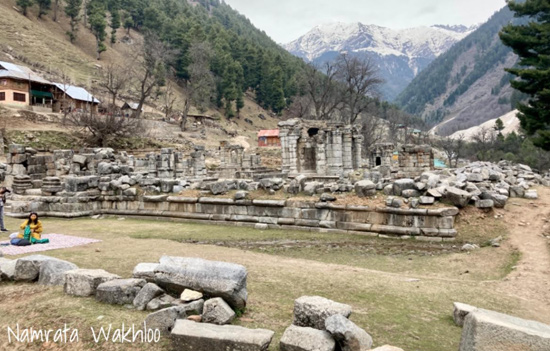
A friend had organized for someone from the local
Gujjar families to meet us enroute. He would show us around the place and also
carry a homemade meal for us.
The Wangath temple ruins, dedicated to Shiva, are
located in Naranag near Kangan above the Sindh valley. The current structure
was built by Lalitaditya of the Karakota dynasty, in the 8th CE. The three
clusters of temples, overlook the Wangath river, which is a tributary of a Sindh
river.

Since ancient times, Nags (serpents) have been
worshipped in Kashmir. It’s said that the Naga Karakotas, who are said to be
Hindu Kashmiri Kayasthas of the Naga sect, known for their reverence of
serpents, named the place Naranag.
The Wangath temples were originally built around the
same time as the Shankaracharya temple in Srinagar and the Bumzoo temple near
Mattan. Kalhana writes in Rajatarangini that Ashoka founded Srinagar in 250
BCE. His son Jaluka, in 220 BCE, built the Shaivite temples Bhuteshvara,
Jyestarudra, and Muthas around the holy spring of Naranag. King Jaluka built a
stone temple at this site around 137 BCE. King Jayendra in 61 BCE used to
worship Shiva Bhutesha at the shrine. Lalitaditya in the 8th CE donated money
to the shrine after his victorious expedition. Avantivarman in 9th CE built a
stone pedestal with a silver conduit at this shrine for the bathing of sacred
images. Kalhana’s father Canpaka and uncle Kanka also would frequent the site
(credits: wiki)
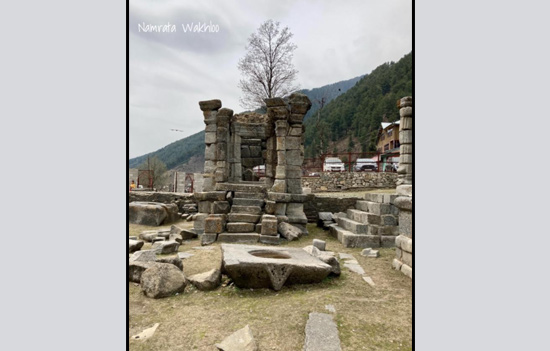
Like the Boniyar temples, these temples are also made
up of huge blocks of granite using interlocking technology. The architecture is
similar to other Kashmir temples of that era. The temples have been plundered
by different invaders at different points of time.
We spent a lot of time admiring the laborious work of
art, took endless photographs to carry back memories.
It was time for lunch. Our Man Friday got the packed
tiffin of Makki ki Roti, butter and pink (salt) tea. We sat down to have a bite
with this fantastic history set as backdrop.
9. PANDRETHAN (dedicated to Shiva)
The great mystic saint Lal
Ded was born in Pandrethan. And here, is located, one of the most exquisite
Shiva shrines of Kashmir. These two highlights always made me want to visit the
place, which is now inside the military cantonment in Srinagar called Badami
Bagh. River Jhelum flows about 100 yards away.
Pandrethan was once the old capital of
Kashmir, believed to have been
founded by King Pravarasena, in 6th CE. The word ‘Pandrethan’ is derived from
‘Puranadishthana’ or old town. The Pandrethan Shiva temple is also known as the
Meruvardhanaswami temple as it was built by Meru, a minister of King Partha,
who ruled Kashmir in 10th CE.
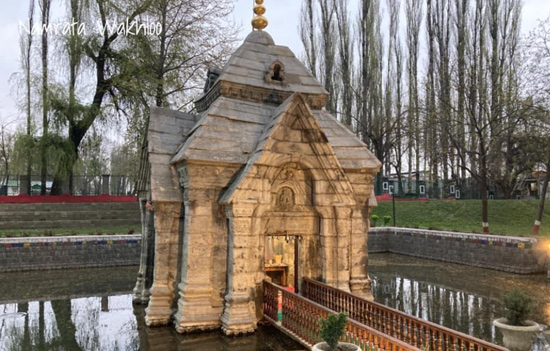
The square stone shrine is like a little jewel sitting
in the middle of water that can be accessed through a footbridge. There are
huge Chinars lending good shade to the surroundings. The roof of this temple is
still in place and is unique as it has been chiselled out of a single block of
stone which is and artistically carved.
Being inside the cantonment area makes it a very high
security zone, hence prior permission from the army is must. It’s also called
as Pani Mandir by the army folks.
This is one of the rare temples of that era, which is
very well maintained and where regular prayers are
conducted. This temple visit was our last one for the day and we reached
here at dusk, just in time for the evening aarti. A priest performed the
Rudra Abhishek and we were so lucky to be a part of the pious ritual. Standing
there, with our hands folded and heads bowed in reverence to the most powerful
one, in this made by our ancestors, a thousand years back, was a very moving
experience. Something which can only be felt and not put into words.
The Pandrethan temple, we realized, is a small part of
a much bigger temple complex. One of the Army guides took us around to the back
of this temple to show us an excavation site which the forces had accidentally
unearthed, some years back. The retrieved architectutal pieces have been
exhibited beautifully in a park. It includes a 10 ft tall Shivling and other
Shivlings of different sizes, along with idols or other deities. These date
back to 6th to 11th century CE, when temple construction in Kashmir was at its
peak.
NOTE: I would sum up by saying that our rich
heritage is crying for attention. It needs to be preserved at any cost. ASI can
definitely do better. Only where it has roped in the Army, the temples are
being taken really good care of. Elsewhere, they are turning into places of
neglect where only picnickers or idle youth hang around.
Stone by stone the gems from the past are falling
apart.
For any queries or any suggestions, please mail me
at namrata.wakhloo@gmail.com
To read all
articles by author
Also read
1.Pics
of Martand Surya Mandir
2. History
of Jammu and Kashmir
3. Verinag
including Shiv Mandir
4. Kashmir’s
Radiant Knowledge Tradition
5. Lalitaditya,
the great Kashmiri King
6. Remembering
Lal Deed, the Kashmiri Yogini